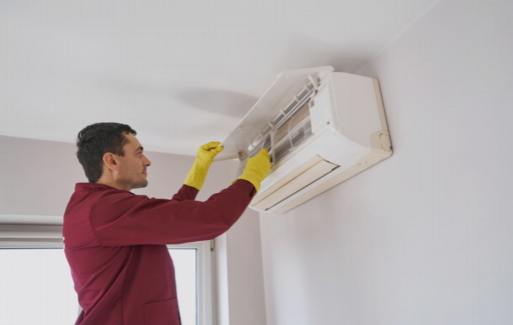Creating a Cool and Comfortable Home: Installing Ceiling Fans for Air Circulation
22 November 2025 by Zuzanna H.As a homeowner, creating a comfortable and pleasant living environment is always a top priority. One essential element of achieving this is ensuring good air circulation throughout the home. In this article, we will explore the many benefits of installing ceiling fans, as well as provide tips for choosing the right fan, proper installation techniques, and strategies for maximizing airflow efficiency. We will also discuss the importance of regular maintenance and upkeep, as well as the potential energy savings and environmental considerations associated with using ceiling fans. By the end of this article, you will have a comprehensive understanding of how ceiling fans can contribute to a cool and comfortable home.

Understanding the Benefits of Ceiling Fans
Ceiling fans are not only a stylish addition to a modern home, but they also provide a range of benefits that can greatly enhance the comfort and functionality of a living space. Whether it's a hot summer day or a stuffy evening, ceiling fans are an effective way to improve air circulation and create a cool and comfortable environment. In addition to their practical uses, ceiling fans can also serve as a decorative element, adding a touch of elegance and sophistication to any room. By understanding the benefits of ceiling fans, homeowners can make informed decisions about incorporating these fixtures into their home design.Choosing the Right Ceiling Fan
When it comes to choosing the right ceiling fan for your home, there are several factors to consider. Size, style, and functionality are all important aspects to keep in mind. It's essential to select a fan that not only complements your home decor but also provides the appropriate level of air circulation for the space. With the wide range of options available on the market, it's important to do your research and choose a ceiling fan that meets your specific needs and preferences.Installation Tips and Strategies
When installing a ceiling fan in your home, there are a few key tips and strategies to keep in mind to ensure a smooth and successful installation. Firstly, always make sure to turn off the power to the existing light fixture or electrical box where the ceiling fan will be installed. Safety should always be the top priority when working with electricity. Next, carefully follow the manufacturer's instructions for assembling the fan and mounting it to the ceiling. It's important to use the appropriate hardware and to ensure that the fan is securely attached to the ceiling to prevent any accidents or damage. If you're replacing an existing light fixture with a ceiling fan, be sure to check that the electrical box is rated to support the weight of the fan. If not, you may need to install a new electrical box that is capable of supporting the fan's weight. Additionally, it's important to consider the height at which the fan will be installed. The blades should be at least 7 feet above the floor for optimal air circulation. If you have high ceilings, you may need to use a downrod to lower the fan to the appropriate height. Finally, always double check your work and ensure that all connections are secure before turning the power back on. It can be helpful to have someone assist you during the installation process, especially when wiring the fan to the electrical system. By following these installation tips and strategies, you can ensure that your ceiling fan is safely and properly installed, providing you with cool and comfortable air circulation in your home.Maximizing Airflow Efficiency with Ceiling Fan Placement
Proper ceiling fan placement is essential for maximizing airflow efficiency in your home. The location of your ceiling fan can greatly impact its ability to circulate air throughout the room. For optimal performance, it is important to ensure that your ceiling fan is installed in the right location. One key factor to consider when placing a ceiling fan is the height of the ceiling. In rooms with standard ceiling heights, the fan should be installed in the center of the room to ensure uniform airflow. For rooms with taller ceilings, the fan should be placed closer to the ceiling to effectively distribute air throughout the entire space. Additionally, the size of the room also plays a role in determining the placement of the ceiling fan. In larger rooms, it may be beneficial to install multiple fans to effectively circulate air. Placing fans strategically in different areas of the room can help to create a consistent airflow and keep the entire space cool and comfortable. It is also important to consider the direction in which the fan blades rotate. During the warmer months, the fan should rotate counterclockwise to create a cooling breeze. In the winter, the fan should be set to rotate clockwise to gently push warm air that has risen to the ceiling back down into the living space. By carefully considering the placement of your ceiling fans, you can maximize their airflow efficiency and ensure a comfortable and well-ventilated home.Ceiling Fan Maintenance and Upkeep
Once your ceiling fan is installed and running, it’s important to keep up with regular maintenance to ensure it continues to function properly and efficiently. Here are a few maintenance tips to keep in mind:- Regularly dust the fan blades to prevent the buildup of dust and dirt which can affect the fan’s performance.
- Check for any loose screws or bolts and tighten them as needed to prevent rattling or noise while the fan is in operation.
- Keep an eye on the fan’s motor and bearings, and lubricate them as necessary to ensure smooth and quiet operation.
- Clean or replace the fan’s air filters to keep the airflow unobstructed and maintain good air quality in the home. By staying on top of these maintenance tasks, you can ensure that your ceiling fan continues to provide effective air circulation and cooling throughout your home for years to come.